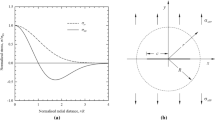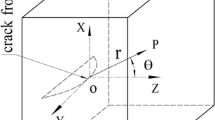Abstract
TheT *ε integral was calculated on the surface of single edge notched, three-point bend (SE(B)) specimens using experimentally obtained displacements. Comparison was made withT *ε calculated with the measured surface displacements andT *ε calculated at several points through the thickness of a finite element (FE) model of the SE(B) specimen. Good comparison was found between the surfaceT *ε calculated from displacements extracted from the FE model and the surfaceT *ε calculated from experimentally obtained displacements. The computedT *ε integral was also observed to decrease as the crack front was traversed from the surface to the mid-plane of the specimen. Mid-planeT *ε values tend to be approximately 10% of the surface values.
Similar content being viewed by others
References
Atluri, S.N., Nishioka, T., andNakagaki, M., “Incremental Pathindependent Integrals in Inelastic and Dynamic Fracture Mechanics,”Engineering Fracture Mechanics,20 (2),209–244 (1984).
Rice, J.R., “A Path Independent Integral and the Approximate Analysis of Strain by Notches and Cracks,”Journal of Applied Mechanics,35,379–386 (1968).
Brust, F.W., Nishioka, T., Atluri, S.N., andNakagaki, M., “Further Studies on Elastic-Plastic Stable Fracture Utilizing the T * Integral,”Engineering Fracture Mechanics,22 (6),1079–1103 (1985).
Nikishkov, G.P., andAtluri, S.N., “An Equivalent Domain Integral Method for Computing Crack-tip Integral Parameters in Non-elastic, Thermo-mechanical Fracture,”Engineering Fracture Mechanics,26 (6),851–867 (1987).
Okada, H., Atluri, S.N., Omori, Y., andKobayashi, A.S., “Direct Evaluation of T * e Integral from Experimentally Measured Near Tip Displacement, for a Plate With Stably Propagating Crack,”International Journal of Plasticity,15 (9),869–897 (1999).
Wang, F.X., May, G.B., andKobayashi, A.S., “Low-spatial-frequency Steep Grating for Use in Moiré Interferometry,”Optical Engineering,33 (4),1125–1131 (1994).
Narisimham, R., andRosakis, A.J., “Three-dimensional Effects Near a Crack Tip in a Ductile Three-point Bend Specimen: Part I—A Numerical Investigation,”Journal of Applied Mechanics,57,607–617 (1990).
Ma, L., Kobayashi, A.S., Atluri, S.N., andTan, P.W., “Crack Linkup by Stable Crack Growth,”Computer Modeling in Engineering and Sciences,1 (4),19–26 (2000).
Dawicke, D.S., Newman, J.C.J., and Bigelow, C.A., “Three-dimensional CTOA and Constrain Effects During Stable Tearing in a Thinsheet Material,” NASA TM-109183 (1995).
Jackson, J.H., Kobayashi, A.S., and Atluri, S.N., “A Three-dimensional Numerical Investigation of the T * Integral Along a Curved Crack Front,” Computer Modeling in Engineering and Science, submitted.
Dodds, R.H.J. andRead, D.T., “Experimental and Numerical Studies of the J-Integral for a Surface Flaw,”International Journal of Fracture,43,47–67 (1990).
Author information
Authors and Affiliations
Rights and permissions
About this article
Cite this article
Jackson, J.H., Kobayashi, A.S. & Atluri, S.N. An experimental—Numerical evaluation of theT *ε integral for a three-dimensional crack front. Experimental Mechanics 44, 207–213 (2004). https://doi.org/10.1007/BF02428180
Received:
Accepted:
Issue Date:
DOI: https://doi.org/10.1007/BF02428180




